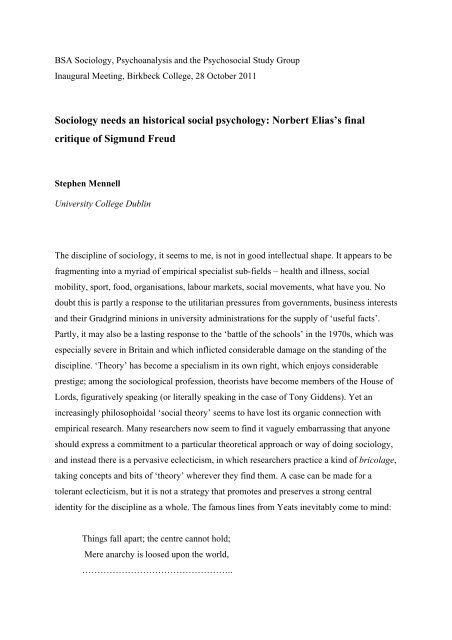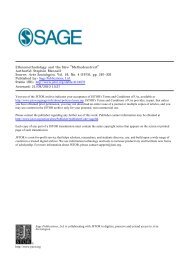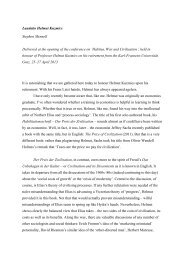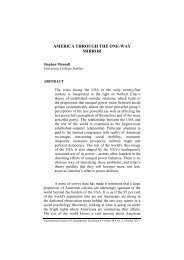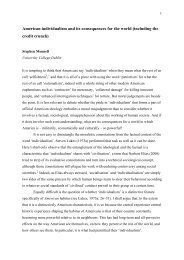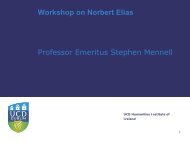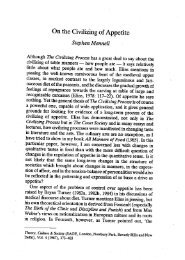paper - Stephen Mennell
paper - Stephen Mennell
paper - Stephen Mennell
You also want an ePaper? Increase the reach of your titles
YUMPU automatically turns print PDFs into web optimized ePapers that Google loves.
BSA Sociology, Psychoanalysis and the Psychosocial Study Group<br />
Inaugural Meeting, Birkbeck College, 28 October 2011<br />
Sociology needs an historical social psychology: Norbert Elias’s final<br />
critique of Sigmund Freud<br />
<strong>Stephen</strong> <strong>Mennell</strong><br />
University College Dublin<br />
The discipline of sociology, it seems to me, is not in good intellectual shape. It appears to be<br />
fragmenting into a myriad of empirical specialist sub-fields – health and illness, social<br />
mobility, sport, food, organisations, labour markets, social movements, what have you. No<br />
doubt this is partly a response to the utilitarian pressures from governments, business interests<br />
and their Gradgrind minions in university administrations for the supply of ‘useful facts’.<br />
Partly, it may also be a lasting response to the ‘battle of the schools’ in the 1970s, which was<br />
especially severe in Britain and which inflicted considerable damage on the standing of the<br />
discipline. ‘Theory’ has become a specialism in its own right, which enjoys considerable<br />
prestige; among the sociological profession, theorists have become members of the House of<br />
Lords, figuratively speaking (or literally speaking in the case of Tony Giddens). Yet an<br />
increasingly philosophoidal ‘social theory’ seems to have lost its organic connection with<br />
empirical research. Many researchers now seem to find it vaguely embarrassing that anyone<br />
should express a commitment to a particular theoretical approach or way of doing sociology,<br />
and instead there is a pervasive eclecticism, in which researchers practice a kind of bricolage,<br />
taking concepts and bits of ‘theory’ wherever they find them. A case can be made for a<br />
tolerant eclecticism, but it is not a strategy that promotes and preserves a strong central<br />
identity for the discipline as a whole. The famous lines from Yeats inevitably come to mind:<br />
Things fall apart; the centre cannot hold;<br />
Mere anarchy is loosed upon the world,<br />
…………………………………………..
2<br />
The best lack all conviction, while the worst<br />
Are full of passionate intensity. 1<br />
What attracted me from economics to sociology back in the 1960s was not an interest<br />
in this or that empirical area of study, but sociology’s promise as the study of the human<br />
condition in general. Sociology departments in those days typically included not just<br />
sociologists per se, but also anthropologists and social psychologists, and not infrequently<br />
staff whose original training had been in history or another discipline among the humanities<br />
and social sciences.<br />
More to the present point, a generation ago a whole range of sociological theorists –<br />
from Talcott Parsons to Norbert Elias, even though those two were poles apart on almost<br />
everything else – took it for granted that a central concern of sociology was to understand the<br />
connection between ‘social structure’ and ‘personality’, both in the modern world and in the<br />
past. Several years before I accidentally encountered Elias (and while I was still studying<br />
with Parsons), I took my own inspiration from David Riesman’s The Lonely Crowd and,<br />
especially, from C. Wright Mills’s famous statement that ‘the sociological imagination<br />
enables us to grasp history and biography and the relations between the two within society’. 2<br />
In order to do that, and in order (at least in part) to remedy the intellectual fragmentation of<br />
contemporary sociology, I contend that we need to make an historical social psychology<br />
central to our intellectual enterprise.<br />
You will not be surprised to learn that in my opinion Norbert Elias made an<br />
outstanding contribution to formulating such an historical social psychology. But I also think<br />
that his contribution is still only partly understood.<br />
Let us start in familiar territory. The concept of social habitus, which had been widely<br />
used in German sociology in the 1920s, was central to his thinking. Yet, for all its popularity<br />
since it was reintroduced by Pierre Bourdieu, the concept still has the capacity to frighten<br />
many sociologists. They are alarmed at any attempt to describe psychological or personality<br />
differences between groups of human beings – differences, more specifically, of habitus. The<br />
symbolic interactionist tradition, from Herbert Blumer to Randall Collins, rejects it outright.<br />
Along with their ethnomethodological offshoot, symbolic interactionists want to explain<br />
human behaviour as situationally generated, with no concern for the longer-term historical<br />
1 William Butler Yeats, ‘The Second Coming’.<br />
2 C. Wright Mills, The Sociological Imagination (New York: Oxford University Press, 1959), p. 6.
3<br />
and cultural shaping of continuities of behaviour within particular social groups. Tony<br />
Giddens, that great voice of the sociological Zeitgeist and political correctness (at least until<br />
Libya), has argued that because all normal human beings can speak a language, there are no<br />
significant psychological differences between peoples. 3 In response to such simplistic<br />
thinking, I often quote a remark by Clyde Kluckhohn and Henry Murray, way back in 1948:<br />
Every person is in certain respects<br />
(a) like all other people<br />
(b) like some other people<br />
(c) like no other person 4<br />
The study of habitus formation unfolds at level (b). It can focus on differences in habitus at a<br />
certain point in time – on the model of Bourdieu’s study of class differences in habitus in<br />
Distinction – or it can be more concerned with changes in how habitus is formed over time,<br />
which was Elias’s principal focus. But, as Elias emphasised more than Bourdieu, habitus<br />
formation is not a simple one-way process. As he shows at some length in The Society of<br />
Individuals, every process of socialisation – through which the social standards of behaviour<br />
and feeling that prevail at a given time are transmitted to individuals – is also simultaneously<br />
a process of individualisation, in which individual people make their own subtle adaptations<br />
of those standards. Socialisation and individualisation are two sides of the same coin.<br />
Let us now be more specific. One of the most important elements in Elias’s thinking –<br />
which he must have taken over in part from Freud – was the close connection between the<br />
prevalent dangers and the prevalent fears in particular social groups. This connection plays a<br />
major part in his sociological theory of knowledge and the sciences, but there is no time to go<br />
into that today. 5 It is also central to his magnum opus and best known work, On the Process<br />
3 Anthony Giddens, The Constitution of Society (Cambridge: Polity, 1984), p. 241: ‘There simply is not<br />
discernible correlation between linguistic complexity and the level of material “advancement” of different<br />
societies. This fact in itself would indicate that there is [sic] unlikely to be any general differences of psychic<br />
organisation between oral cultures and “civilisations” on the other.’<br />
4 Clyde Kluckhohn and Henry Murray (eds), Personality in Nature, Society and Culture (New York: A. A.<br />
Knopf, 1948), p. 35.<br />
5 See in particular Involvement and Detachment (Dublin: UCD Press, 2007 [Collected Works, vol. 8]) and<br />
Essays I: On the Sociology of Knowledge and the Sciences (Dublin: UCD Press, 2009 [Collected Works, vol.<br />
14]).
4<br />
of Civilisation. 6 Too often sociologists have failed to see the link between the first volume,<br />
dealing with manners, and the second, dealing with state formation and violence. Roughly<br />
speaking, the first volume can be seen as ‘Freudian’ in flavour, and the second as ‘Marxist’<br />
(or perhaps Marxist–Weberian). Once we recognise the centrality of the connection between<br />
fears and dangers, then the connection between the two original volumes also becomes clear.<br />
Elias seems not to have cited Freud’s writings at all until he left Heidelberg in 1929 to<br />
become Karl Mannheim’s assistant in Frankfurt. But then, in the 1930s, he uses Freudian<br />
terminology (such as ‘superego’) quite a lot – more, in fact, than is evident in the original<br />
English translation. Post-war, Freudian terms are less evident, but that does not indicate a<br />
change in Elias’s fundamental thinking. After all, after the war he was one of the founders,<br />
along with S. H. Foulkes, of the techniques of group analytic therapy. The problem – at least<br />
for social scientists and others who have become uncomfortable with Freudian ideas – is that<br />
Elias never spelled out quite where he stood in the complicated map of Freud’s legacy.<br />
Or at least, he did not spell it out until the very last few months of his life. After the<br />
publication of The Society of Individuals, The Germans and The Symbol Theory, he seems to<br />
have been aware that this was perhaps the last remaining lacuna in his work. He began to<br />
dictate a long text entitled ‘Freud’s concept of society and beyond it’. But by then he was<br />
practically blind, and he was dependent on a rotating team of Dutch assistants, who each day<br />
had to read back to him what he had dictated (perhaps to a different assistant) the day before;<br />
sometimes they seem to have been unsure which of several late texts they were working on. 7<br />
The result, when Elias died on 1 August 1990, was a chaotic 130-page typescript (in English)<br />
full of repetition. For twenty years, we thought it was unpublishable. But then, in 2009–10,<br />
the French historian Marc Joly studied the text in great detail and found in it a perfectly<br />
coherent argument. By an editing tour de force he reorganised it into a roughly 50-page<br />
<strong>paper</strong>, which we authorised him to publish in French this year; 8 an English version of it will<br />
be published in the final volume of the Elias Collected Works. Marc Joly in effect cut up<br />
Elias’s typescript into about a hundred strips, then reassembled them under headings<br />
6 Norbert Elias, On the Process of Civilisation (Dublin: UCD Press, forthcoming, spring 2012 [Collected<br />
Works, vol. 3]).<br />
7 For a detailed account of the circumstances in which Elias worked in the last months of his life, see Richard<br />
Kilminster’s ‘Note on the text’ in Elias, The Symbol Theory (Dublin: UCD Press, 2011 [Collected Works, vol.<br />
13]).<br />
8 Norbert Elias, Au-delà de Freud (Paris: La Découverte, 2011), pp. ???–??.
5<br />
(invented by Joly) which link closely to several of the key ideas in Elias’s work thinking as a<br />
whole. The rest of my <strong>paper</strong> will be devoted to a summary of ‘Freud’s concept of society and<br />
beyond it’, largely in Elias’s own words (from beyond the grave, so to speak).<br />
A summary of ‘Freud’s concept of society and beyond it’<br />
Introduction<br />
‘Sociology and psychoanalysis, as I understand them, have this in common that they use as<br />
their point of departure a concept of human beings as processes – in short, a dynamic concept<br />
of people. That is in contrast to action, system or metaphysical theories which use as their<br />
point of departure a static concept of a human being as an adult person who has never been a<br />
child. Freud worked out what I still believe to be the most reality-congruent theoretical model<br />
of the process during which a newly-born baby becomes an adult. Freud did not perhaps state<br />
clearly enough that the unique growing-up process of young humans characterised by such<br />
concepts as oral, anal and genital stage, was a double process. Its two component processes, a<br />
biological process of maturation and a social process of learning, continuously dovetail into<br />
each other.<br />
Freud recognised that the self-regulating functions which are popularly known by<br />
such names as ‘reason’ and ‘conscience’ developed in the course of this process. But he<br />
found it once again convenient to conceptualise the formation of these functions of selfregulation<br />
as if they were static objects. He called them by names such as ego, superego and<br />
ego-ideal. In spite of his own recognition of the indispensable role which experiences with<br />
other people and the concomitant conflicts played in the formation of an individual pattern of<br />
self-regulation fixated in a person’s memory, he was not yet in a position to recognise the<br />
extent to which changes in social structure [e.g. from peace to war or from a strictly<br />
authoritarian to a less authoritarian family] could influence the emerging personality structure<br />
of a generation and this in turn, when fully matured, structural characteristics of society at<br />
large. Although he once said that basically all psychology was social psychology, as far as I<br />
can see he was not fully aware of the extent to which the patterns of self-regulating agencies<br />
such as ego and superego and their relationship to the regulated drives could change and did<br />
in fact change during the development of human society.’ …<br />
In short: ‘one can perhaps say that the Freudian model of an individual is eminently<br />
sociological. His model of society is eminently individualistic.’
6<br />
1 A theory of society based on the individual–society dualism<br />
Freud ‘brings to bear the conceptual tools developed in studies of individual neuroses upon a<br />
common sense view of society. … His immediate experiences confirmed the widely held<br />
view of an antagonism between individual and society. In the manner of his time Freud saw<br />
the submission of human drives to regulating restraints only as a symptom of an individual’s<br />
subordination to society. He did not yet perceive drive-regulation as a condition of the<br />
relative autonomy of individuals in their relations with themselves as well as in their relations<br />
with others.<br />
‘One of the symptoms of Freud’s basic individual-centeredness is the rarity of his use<br />
of the pronoun “we”. If used at all, “we” is seldom more than a substitute for “one” or “I”.<br />
His view of society is essentially the commonsense view, that it is the sum total of<br />
individuals. The awareness that group processes have a structure of their own and cannot be<br />
understood if one is concerned with the individual person as if each of them were alone in the<br />
world, is lacking in Freud’s writing, except in one case were society is indeed nothing else<br />
but a crowd, in Mass Psychology and the Analysis of the Ego.<br />
‘To a large extent this limitation is connected with Freud’s therapeutic task. He is<br />
after all concerned with psychological difficulties of individuals. However, these difficulties<br />
are almost invariably connected with problems a person experiences in a group. Freud was<br />
not unaware of this fact. His brief observation that all psychology is after all social<br />
psychology, bears witness to this fact. The knowledge of this fact conflicted with Freud’s<br />
deeply rooted assumption that the basic structure of the human personality forms part of the<br />
human biological inheritance. It was a conflict he was never able to solve. … Concepts such<br />
as ego, superego and ego-ideal are characteristic of Freud’s productivity, but also of his<br />
limitations.<br />
The I-level and the we-level of a person are inextricably interwoven. In any<br />
contemporary society the identity of a person is often symbolically represented by a family<br />
name and a personal name locked together. If a person introduces herself as Ann Anderson,<br />
one knows that she is an offspring of an Anderson family and that Ann is a symbol of her<br />
distinctness in relation to other members of that family. Her personal friends may call her<br />
simply Ann. Her family name is the symbol of one of the groups of which she can say ‘we’.<br />
Her first name identifies her as an individual member of that group.<br />
It is astonishing that the separate entity of each individual as a physical existence, as a<br />
separate feeling and memory agency, as a distinct growing and decaying entity, can in the
7<br />
eyes of so many people conceal the profoundly social character of the individual person, the<br />
belongingness to a we-group.’ …<br />
‘In accordance with a widely held belief, Freud seemed to assume that repression and<br />
restraint of affects and drives in general is required of an individual person only for the sake<br />
of others, of society. One may easily forget that one is oneself another person for others who<br />
may feel that one stands in the way curtailing fulfilment of their desires. But the fulfilment of<br />
one’s own needs also depends on others. The narcissistic character of the conception of<br />
individual and society as antagonistic stands out more clearly if one considers that fulfilment<br />
and frustration of desires alike depend on others.’<br />
2 A myth of origins<br />
‘Like Hobbes and the social contract philosophers, Freud asked about the beginning of<br />
society. Hobbes and Freud had this in common, that they assumed a condition of unbridled<br />
individual violence preceding the emergence of social life as we know it, life in societies,<br />
where the use of violence is to some extent effectively controlled. … The question of the<br />
beginning of human society has given rise to a number of famous scientific legends. Freud’s<br />
suggestion of a patricide in a primeval horde is one of these.’ … But ‘all the evidence points<br />
to beginningless processes. There is no good reason to reject the obvious suggestion that<br />
human societies evolve from animal societies as part of a continuous process in the course of<br />
which pre-human ancestors transformed themselves into hominids of the present type.’ …<br />
The capacity of humans, ‘as well as their need for learning means of orientation and, above<br />
all, the symbols of a language, became much greater. And greater therefore is also the ability<br />
of human societies to change their structure and characteristics, to adjust them to<br />
circumstances wholly beyond the reach of the learning capacity available in pre-human<br />
societies.’ …<br />
‘Freud might not have felt the need for inventing his myth of the primeval band of<br />
brothers, a more colourful rehash of the social contract theory, if he had accepted the<br />
evolutionary model of the origins of society. He seems to have accepted as a matter of course<br />
the evolutionary descent of human beings, but for unknown reasons did not allow it to play<br />
any part in the exposition of his own psychoanalytic theory.’<br />
3 Social repression and psychological repression<br />
‘Freud was … not much concerned with differences in the repressive character of different
8<br />
societies. He saw society per se as a quasi-existential agency of repression. It was society in<br />
that sense which he regarded as the eternal antagonist of the individual human being. He<br />
probably was not unaware of the fact that the degree and the pattern of social repression<br />
differed widely from one society to another. There is much evidence in favour of the<br />
assumption that the social habitus, the individual personality structure and thus also the<br />
pattern of psychological repression of people who live in a long-lasting autocratic regime,<br />
differ markedly from those of people living under a long-lasting parliamentary regime. Our<br />
own age offers striking examples of this type of connection. A telling example is the change<br />
in the social position of young unmarried women which took place in some of the more<br />
advanced industrial societies of Europe during the twentieth century, particularly in the urban<br />
and rural middle classes. It is not difficult to recognise that the social habitus and the type of<br />
personality structure of young women underwent corresponding changes.’<br />
There then follows a fairly long discussion of changing sexual mores in the twentieth<br />
century; Cas Wouters has developed a very detailed theory of ‘informalisation’ about this.<br />
Elias finally returns to how this relates to his own theory of civilising processes:<br />
‘By suggesting that the recent changes in standards of sexual conduct of sections in<br />
the more advanced European societies represent a civilising spurt, I may be found guilty of a<br />
self-contradiction. The use of the term ‘civilising spurt’ may seem to stand opposed to the<br />
examples of a civilising spurt I presented in the first volume of Über den Prozess der<br />
Zivilisation (1939). In that volume I mentioned an old English dictum as an abbreviated<br />
symbolic indicator of the processes under observation, the saying: ‘Things once allowed are<br />
now forbidden’. Now I am suggesting that one may come to regard as a civilising spurt a<br />
change in the opposite direction: ‘Things once forbidden are now allowed’. What one<br />
encounters here is an experience not uncommon in a long research process. A theory which<br />
one believed at first universally applicable, reveals itself in the course of further research as<br />
applicable only to part of the relevant field. One may have to look for a more comprehensive<br />
model which covers the whole ground. Civilisation is, as I have indicated before, an<br />
unintended and impersonal biosocial process as well as a planned social ideal towards which<br />
people may work deliberately. Both culture and civilisation are in danger of being understood<br />
as objects in a stationary condition. It requires an effort to perceive culture and civilisation<br />
instead as intergenerational processes of long duration, capable of retrogression as<br />
progression. It formed part of the overall development of humanity.<br />
‘As I have often pointed out before, the extremes of both restraint and unrestraint lie<br />
beyond the range of what is customarily regarded as civilised behaviour. The difficulty is that
9<br />
civilisation is two things rolled into one. It is at the same time an unplanned social process<br />
and a human ideal thought to lie within the range of deliberate human planning.’ …<br />
‘One cannot say that a change towards greater or towards lesser restraint in peoples<br />
pattern of self-regulation has per se the character of a civilising process. It can have just as<br />
well a decivilising character. The decisive criterion of the civilising character of a long term<br />
change in self-regulation is not the advance or decline in the standards of self-regulation as<br />
such, but the implications of such changes for the human beings concerned, and in particular<br />
for their life with each other.’ …<br />
‘Whether or not it is advisable to link the discovery of the changes of conduct and<br />
feeling to the concept of civilisation, is a different question. I still think it was the right<br />
decision to do that. Given enough time it will fight itself free from the skein of ideologies to<br />
which it is at present still wedded, and become a useful scientific term. … At present it is still<br />
a bit difficult to understand that civilisation is a comparative term. In the development of<br />
humanity there is no zero point of civilisation, only different stages. Expressed differently,<br />
there are no absolutely uncivilised human groups.’<br />
4 Towards a processual reorientation of Freudian concepts<br />
‘Freud made what is probably the greatest single advance towards an overall model of the<br />
functioning of a person that has been made so far. Like the theory of the evolving universe, it<br />
was a process-theory. It was essentially a model of the development of the human person<br />
from birth to adulthood.’ … Yet although ‘at the individual level, Freud recognised very<br />
clearly the process-character of the relationship between libido and libido-control, he was not<br />
particularly interested in the social and biological levels of the relationship between drive and<br />
drive control. His reflections about these levels remain non-processual. His questions have a<br />
stationary frame of reference.’ Therefore in this section Elias examines the concepts of<br />
‘libido or the Id on the one hand, and libido-controlling agencies such as “ego” and<br />
“superego” on the other hand’, and prepares them for a ‘restructuring in process-terms’.<br />
Drives and drive-controls: ‘Freud was inclined to consider drives as natural, drive<br />
control as social and thus as not natural. However, not only human beings but also many<br />
animals possess a capacity for controlling their drives. But animal species can rely to a very<br />
large extent on innate mechanisms of drive-control and only to a smaller extent on restraints<br />
due to remembered experiences. In the case of humans, the scope of innate drive-control is<br />
comparatively small, while the scope for learnt drive-control is by comparison very large. As
10<br />
it has become customary to order to order one’s thoughts in terms of a simple black and white<br />
design, one may be inclined to classify as natural only human properties not acquired through<br />
learning. Yet self-regulation in the form of drive-control shares with language the<br />
dependence on a natural potential that has to be activated through a learning process. It<br />
cannot fulfil its regulating function if it is not patterned by the acquisition through learning of<br />
specific regulations.<br />
‘Freud looked at the problems of human self-regulation and particularly of drive<br />
control from a specific angle, from that of a doctor who is trying to understand the suffering<br />
of his patients and to help them. His image of a person and indeed his whole vocabulary was<br />
coloured by this perspective. In the foreground of his vision stood specific types of driveregulation,<br />
above all types which cause suffering and which could be regarded as symptoms<br />
of illness, such as repression or displacement. … One cannot be sure whether Freud took<br />
fully into consideration that neither repression nor sublimation or any other form of driveregulation<br />
would be possible without the natural plasticity of human drives and the natural<br />
potential for developing through individual experience drive-regulating agencies whatever<br />
they may be called, reason and conscience or Ego and Super Ego. The natural constitution of<br />
humans makes it possible for them to develop forms of self-regulation of one kind or another.<br />
We know very little about how and why in the case of different people different forms come<br />
to prevail. However, it becomes very clear that human beings not only can learn specific<br />
patterns of self-regulation. They also must learn self-regulation in order to become fully<br />
human. … The human capacity for self-regulation … has a high survival value for the<br />
individuals concerned no less than for the groups which they form with others.’ …<br />
The unconscious: ‘Perhaps the best known and the most controversial of his<br />
discoveries is that conceptualised by Freud himself as the unconscious. … In [an] early<br />
essay, Freud still shows some awareness of the adjectival character of the term unconscious.<br />
… One can say of human beings that they are unconscious. Memories may be forgotten and<br />
thus said to be unconscious but the use of an adjective as a noun is an untidy procedure. It<br />
suggests that the property of an object is an object in its own right. Freud came to use the<br />
adjective unconscious as a noun. … He conceptualised his findings by presenting the fact that<br />
the lost experiences were beyond recall by suggesting that they were in the unconscious. The<br />
quality of certain experiences presented itself in that way as a kind of container, as a vessel<br />
within which experiences were stored, or perhaps as a room within the human frame. A<br />
discovery of great consequence which was inherently controversial was rendered more<br />
controversial than it needed to be by a misleading conceptualisation by familiar phrases such
11<br />
as “in the mind” for the use of the term unconscious as if it were a container.’ But in fact ‘the<br />
term “unconscious” refers to forgotten memories that remain active evoking specific feelings<br />
and actions of people. Freud’s discovery that a person’s memory of past experiences which<br />
have been completely forgotten are at the root of the compelling mechanisms well known<br />
from neuroses and related illnesses has far-reaching consequences for the understanding of<br />
human beings. The traditional paradigm with which one works today in studies of human<br />
beings presents us with the choice between the genetically determined and thus unlearned<br />
compelling mechanisms of human nature and the deliberate, more or less freely chosen<br />
actions of a grownup human person. Freud found a third level of integration. He discovered<br />
compulsory mechanisms of a person which are not innately fixated, which are due to a<br />
person’s experiences and in that sense learned.<br />
Ego–superego: ‘The concept of superego was an improvement upon the traditional<br />
concept of conscience, or that of ego was an improvement upon traditional concepts such a<br />
“reason” or “mind”. … Perhaps one can see better the full significance of Freud’s discovery<br />
if one compares the picture of human beings that emerges from his findings with the<br />
traditional picture of persons underlying the ruling philosophical tradition from Descartes and<br />
Kant through to Popper. Their reflections are based on the assumption that human intellect<br />
normally functions in a rational or logical manner. Freud broke with the tradition which<br />
represented human beings as naturally rational. The nearest Freudian equivalent to the reason<br />
and ratio of the philosophers and its derivatives is the concept of ego, a set of mental<br />
functions which mediate between the microcosm of a person and the macrocosm of the world<br />
at large. Comparatively little work has been done on the development of the human selfimage.<br />
Freud has made a significant contribution to this development. One of the major<br />
advances due to Freud is his implicit rebuttal of a picture of people which over-accentuates<br />
the human capacity for producing reality-congruent symbols and his attempt at giving<br />
libidinal impulses and fantasy knowledge their due.’<br />
Nevertheless there remains the danger of what, elsewhere, Elias called conceptual<br />
Zustandsreduktion or ‘process-reduction’: ‘As they are used now, the terms Ego and<br />
Superego give the impression that they apply to different objects, to distinct chambers of a<br />
person’s intellect. Thus one may say that something is ‘in the unconscious’ as if ‘the<br />
unconscious’ were one drawer in a chest of drawers. Or one may say that the ego does this or<br />
that, as if it were a little person within a person. It would be more accurate to speak in both<br />
cases of self-regulating functions, probably performed by the cerebral cortex when its<br />
potential for drive and conduct-control has been activated by learning.
12<br />
5 Beyond nature and culture<br />
Finally, in the last of the sections created by Marc Joly, Elias returns to a topic that concerned<br />
him from his earliest academic essay in 1922 to his last completed book, The Symbol Theory,<br />
in 1989 – the false duality between ‘nature’ and ‘culture’. ‘It is only the innocently<br />
anthropocentric character of human concepts’, he wrote, ‘which makes it worthwhile for<br />
people to stress the different modes of existence of events that are due to the action of human<br />
beings which are therefore classified as “culture” or “civilisation”, and of those which are not<br />
and are classified as “nature”. … Freud did not make this mistake. He recognised as distinct<br />
the animalic level of existence and wrestled with the problems arising from the fact that<br />
humans are in some respects animalic and in some respects not. [But] he saw the relationship<br />
between animalic and post-animalic levels of human beings in a simplified way as a purely<br />
additive relationship. Thus he defined culture and civilisation as the “achievements and<br />
regulations which distinguish our lives from those of our animal ancestors”. He saw humans<br />
only as something more than animals, not also as beings evolved from animals into<br />
something else.’ Elias then went on to give a brief sketch of the argument of The Symbol<br />
Theory, the introduction to which he was writing at the same time as the Freud essay.<br />
The last note that Elias strikes, however, is to draw attention to the interdependence of<br />
the human sciences if we are to achieve an adequate understanding of the human condition:<br />
‘Psychoanalysts, by the very nature of their method, can have only an indirect access to the<br />
growth process of a person. They have to reconstruct it from the evidence provided by the<br />
reminiscences and behaviour of their adult patients. Valuable as it is, this type of research<br />
requires supplementation by means of direct research into the building up of civilising<br />
restraints, of forms of self-regulation by human beings on the road from infancy to adulthood.<br />
Child analysts hold a key position in advancing this work. They witness in vivo children’s<br />
responses to parental challenges and parents’ responses to the challenge of their child. [But]<br />
they may not be trained to consider the parents’ response to the demands of their society’ –<br />
which by implication is one of the special tasks of sociologists. And ‘anthropologists too<br />
could play a key role in this field, especially if they were trained for systematic comparisons<br />
of the upbringing of children in different societies’ – which, of course, was one of the central<br />
foci of the ‘culture and personality’ school of anthropology active between the 1920s and the<br />
1960s, but which seems to have disappeared almost entirely today.<br />
That must suffice. I hope I have given you a flavour of Elias’s critical appreciation of
13<br />
Freud, and also of why Elias and his followers see the need for an historical social<br />
psychology as a key component of a renewed, intellectually more ambitious sociology.


